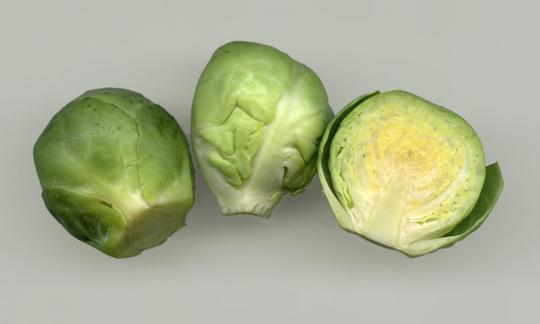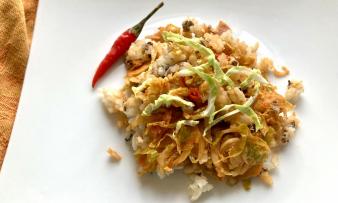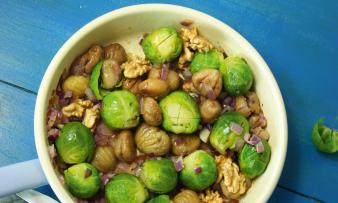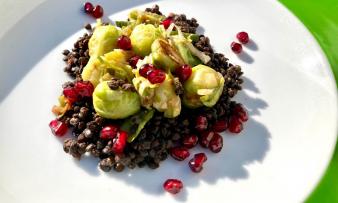Table of contents
Brussels sprouts ( Brassica oleracea var. gemmifera) are a variety of cabbage and can be eaten raw (preferably organic), but are more digestible when cooked.
Use in the kitchen
Depending on the variety, Brussels sprouts have a strong, aromatic to mild, sweet, slightly nutty taste. The effects of frost and the correct cooking method can also influence the taste. There are both green and purple varieties, which hardly differ in taste. The cooked consistency can be described as finely creamy. When preparing Brussels sprouts, you should remove the outermost leaves from the florets, cut back the stalks, wash the heads and drain well. If you eat them cooked, cutting the base of the stalk crosswise helps to ensure even cooking.
Can you eat Brussels sprouts raw? Brussels sprouts are edible raw, but in this form they are usually difficult to digest. If you want to eat them raw, you should start with small amounts. It is best to shred, slice or cut the Brussels sprouts (raw) into thin slices and mix the chopped florets into the salad. Brussels sprout salad tastes good with nuts (e.g. walnuts) or fruit (e.g. pomegranates, apples, cranberries). It is also recommended to eat it with fennel (or other vegetables, raw) in an orange dressing. When using raw Brussels sprouts, make sure that they are freshly harvested and do not show any discoloration or wilting.
Brussels sprouts blanched, steamed, cooked, fried or roasted are slightly easier to digest than raw Brussels sprouts. As the saying goes, brevity is the soul of wit. Brussels sprouts take a short time to cook. If you cook them for too long, you lose consistency, flavour and nutrients. Brussels sprouts can be easily prepared as a vegetable side dish for all kinds of vegetarian and vegan dishes, for example as part of a vegan autumn plate with spaetzle (knöpfli), vegan strips and a warm pear half with cranberries, or as a side dish to a pumpkin risotto. They also go well in creamy soups, curries, tofu vegetables or in sauces for pasta or gnocchi. They can also be made into a puree or briefly roasted in a pan with smoked tofu.
Brussels sprouts can also be baked and gratinated. It is better to blanch Brussels sprouts before putting them in the oven. We recommend casseroles with potatoes and/or chestnuts. Brussels sprouts also taste great baked with other vegetables or with soya mince.
Are Brussels sprouts bitter? The small cabbages often appear on lists of most hated vegetables because they can taste a little bitter due to sulphur-containing compounds. Cooking them for too long intensifies this slightly bitter taste even more. But if you only cook Brussels sprouts for a short time and season them properly, you can look forward to a natural sweetness. 12
Vegan recipe for Brussels sprouts salad
Ingredients (for 4 people): 800 g raw Brussels sprouts (organic), lamb's lettuce, 1 pomegranate, 100 g walnuts, 3 tbsp tahini, 3 tbsp pomegranate syrup, 100 ml vegetable stock, 1 clove of garlic, 1 tsp harissa (hot spice paste), some salt andpepper, 2 tbsp rapeseed oil.
Preparation: First prepare the dressing. To do this, mix the tahini, pomegranate syrup, vegetable stock, the peeled garlic clove and harissa with a blender or hand blender and season with salt and pepper. Wash the Brussels sprouts, blanch them briefly in boiling, lightly salted water and rinse with cold water. Wash the lamb's lettuce and drain. Open the pomegranate and remove the seeds. If you like, you can briefly roast the Brussels sprouts in a pan heated with a little rapeseed oil. Arrange the lamb's lettuce on plates, place the Brussels sprouts on top and drizzle the dressing over them. Sprinkle the vegan Brussels sprout salad with pomegranate seeds and walnuts and serve.
Vegan recipes with Brussels sprouts (raw) can be found under the note: " Recipes that have the most of this ingredient ".
| Not only vegans or vegetarians should read this: Vegans often eat unhealthily. Avoidable nutritional errors. |
Purchasing - Storage
Fresh Brussels sprouts (raw) can mainly be found in larger branches of supermarket chains such as Coop, Migros, Denner, Volg, Spar, Aldi, Lidl, Rewe, Billa, Edeka or Hofer. Many of these supermarkets also sell frozen Brussels sprouts. Organic supermarkets (e.g. Alnatura, Denn's Biomarkt) also offer the cabbage, naturally in organic quality. During the Brussels sprouts season, which lasts from September to February in Central Europe (regional variations possible, in Germany, for example, from August to December 15), you can get particularly fresh and local Brussels sprouts at weekly markets. Occasionally you will find the florets sold on the stalk, which looks nice and keeps the Brussels sprouts fresh longer.
The availability of Brussels sprouts varies depending on the size of the store, catchment area, etc. If you are interested, click on our recorded food prices for the DA-CH countries (above under the ingredient image). There you will find current prices from various supermarkets and their price development.
Storage tips
Raw Brussels sprouts should be stored unwashed and "uncleaned" in the vegetable compartment of the refrigerator so that they do not start to rot and stay fresh longer. This way they can be kept for up to a week. Can you freeze Brussels sprouts? You can freeze cooked Brussels sprouts. To do this, cook them for 4-5 minutes in boiling salted water, drain them, let them cool completely and then pack them in sealable freezer bags or containers. Although the cabbage will now last longer (around a year), it loses its firmness through cooking and freezing. Can you freeze raw Brussels sprouts? In principle, you can freeze raw Brussels sprouts. However, this increases the risk of germs.
Ingredients - Nutritional values - Calories
Brussels sprouts (raw) are a low-calorie and almost fat-free vegetable with 43 kcal and 0.3 g fat per 100 g. The protein content is 3.4 g/100g. Some other types of cabbage, such as savoy cabbage (2 g/100g), red cabbage (1.4 g/100g) and white cabbage (1.3 g/100g), have slightly less protein, while kale (4.3 g/100g) has slightly more. 1
Do Brussels sprouts contain vitamins and essential nutrients? Brussels sprouts contain a significant amount of vitamin K, namely 177 µg/100g, which is 236% of the daily requirement. Spring onions contain a similar amount (207 µg/100g). Kale contains even more vitamin K, at 705 µg/100g. 1
The vitamin C content is also noteworthy. This is 85 mg/100g (106% of the daily requirement). The content can be compared with that of broccoli (89 mg/100g) and green bell peppers (80 mg/100g). Yellow bell peppers contain just over twice as much vitamin C at 184 mg/100g, but kale also contains more at 120 mg/100g. 1
100 g of Brussels sprouts also contain 61 µg of folate (31% of the daily requirement). Cauliflower (57 µg/100g), white cabbage (57 µg/100g) and pak choi (66 µg/100g) have similar levels of folate. Pulses contain a lot of folate, such as mung beans (625 µg/100g), but these usually have to be cooked before consumption, which reduces the level. 1
The complete ingredients of Brussels sprouts (raw), the coverage of the daily requirement and comparison values with other ingredients can be found in our nutrient tables. In the article Nutrients explained you will get a detailed insight into the topic.
Health effects
Are Brussels sprouts healthy? Brussels sprouts are ideal for people who are overweight or have heart disease because of their low fat content. They also contain some fiber - this is good for digestion by having a laxative and regulating effect on the intestines. Like other types of cabbage, Brussels sprouts contain relatively more potassium than sodium, which is particularly beneficial for people with high blood pressure and fluid retention (edema). 2 However, the way they are prepared has a strong influence on the nutrients in Brussels sprouts and their health effects.
Regular consumption of Brussels sprouts and cruciferous vegetables in general is said to have a detoxifying effect and can reduce the risk of cancer. 3 This anti-cancer effect is mainly due to the secondary plant substances they contain (e.g. glucosinolates). 4 Brussels sprouts have an antioxidant effect and can protect against oxidative damage to cells and DNA. 5
There are also studies that support the hypothesis that increased consumption of cruciferous vegetables can prevent arteriosclerosis. 13
Dangers - Intolerances - Side effects
Brussels sprouts, like other brassicas, can cause flatulence and thus stomach pain. Spices such as cardamom, cumin, coriander or ginger can reduce or even prevent these side effects. Seeds of anise, fennel or caraway used as a spice or prepared as a tea are also suitable for counteracting flatulence.
Food allergies or those to Brussels sprouts are possible, but rare. If they do occur, they are more likely to be food intolerances, which manifest themselves in the form of stomach pain and flatulence.
Folk medicine - natural medicine
In folk medicine, Brussels sprouts are considered a warming winter vegetable that strengthens the immune system. Traditional Chinese Medicine ( TCM) also says that they help with exhaustion, lack of energy and poor concentration and improve mood. They are also said to promote the excretion of fluids and are useful against constipation. 6
Ecological footprint - animal welfare
The ecological CO 2 footprint of fresh, regional Brussels sprouts is relatively low at 0.3 kg CO 2 e/kg and is similar to that of broccoli or kohlrabi. 16 The water requirement is also comparable to that of broccoli; around 285 litres of water are needed to produce 1 kg of Brussels sprouts. 17 When shopping, you should pay attention not only to regionality but also to the method of cultivation. Brussels sprouts can be bought from organic or conventional cultivation. Since organic farming does not use synthetic fertilizers or pesticides, this type of cultivation is usually more environmentally friendly than conventional methods. Organic farmers do not use chemical agents to combat the cabbage whitefly, but rather use fine-mesh nets and natural opponents or beneficial organisms (e.g. parasitic wasps). 11
When growing Brussels sprouts organically, the time of sowing, plant spacing, crop rotation and fertilization are very important in order to achieve good quality. Harvesting is labor-intensive, as the florets are cut from the stalk individually and by hand. After harvesting, leftover plant material remains in the fields, which returns nutrients to the soil. 11
Worldwide occurrence - cultivation
Brussels sprouts most likely originate from Brussels in Belgium, where they were probably cultivated from the 13th century onwards. There are records from the 16th century (1587). In the 18th century, the French coined the name of the vegetable, namely Choux de Bruxelles, which also became popular in the USA as brussels sprouts. The German alternative name Brüsseler Kohl also indicates its origin. 6,7
The origins of Brassica oleracea var. gemmifera are not entirely clear. It is suspected that it was a mutation or a natural or accidental cross with a wild cabbage species. 8
Brussels sprouts are now grown in many European countries, such as the Netherlands, Belgium, Great Britain, France and Italy, but they are also popular in China and the USA. 6
Cultivation - Harvest
To achieve a good harvest of Brussels sprouts, you need deeply loosened soil enriched with humus. You can plant them in the garden from mid-April to the end of May. You can either sow Brussels sprouts directly in the bed or grow seedlings on planting trays in early spring before planting them in the garden. You can also buy pre-grown Brussels sprout seedlings. You should leave a distance of 50 cm between the individual plants, as they grow expansively over the course of the year. The seedlings should be watered sparingly so that they develop deep roots. After that, the Brussels sprouts like it moist, so they need regular water, but waterlogging should be avoided. You should also start fertilizing the plants moderately in mid-summer at the latest. 8
The Brussels sprouts grow on a stalk that can reach a height of up to 1 m. Around 15-20 leaf florets (buds) grow close together and in a spiral shape in the leaf axils along the stem. In commercial cultivation, Brussels sprouts plants initially grow in seedbeds or greenhouses before being transplanted into the fields. After 90-180 days, the florets are ready for harvest. Depending on the variety, they are picked by hand or harvesting machines are used. 10 Depending on the variety, the harvest takes place from autumn to spring either by hand or using harvesting machines. 10 The best way to harvest the walnut-sized and still tightly closed florets by hand is to cut them off with a knife or carefully break them off the leaf axils. Always harvest the thickest (approx. 2-4 cm diameter) and ripest florets first - from the bottom of the stalk upwards. A small head often forms that can be used like savoy cabbage. 8,9 As a classic winter vegetable, the best time to harvest (depending on the variety) is after the effects of frost to complete its flavor.
With a well-planned crop rotation and at least a 3-year break between growing all cabbage varieties in the same bed, cruciferous diseases such as clubroot can be successfully avoided. 8 A large proportion of the Brussels sprouts grown are hybrid varieties and therefore incapable of reproduction. However, there are some breeders who are committed to preserving old, fertile varieties. 11
Further information
Brussels sprouts ( Brassica oleracea var. gemmifera) belong to the cruciferous family (Brassicaceae) and are a variety of cabbage. There are early, lighter varieties and late, slightly darker varieties.
The risk of a goitrogenic (strumigenic) effect on the thyroid (inhibition of iodine uptake and thus enlargement of the thyroid) does not exist when eating normal amounts of Brussels sprouts (cooked). 14 Such effects on the thyroid only occur when large amounts or exclusive consumption of goitrogenic foods are combined with an iodine deficiency.
Alternative names
Brussels sprouts are also called Brussels cabbage, Brussels sprouts, little rose cabbage, cabbage rosettes, Brabant cabbage (Brabanter) and rose savoy cabbage. In Austria it is called Sprossenkohl and Kohlsprossen. Incorrect spellings such as Rosenkphl, Rossenkohl, Röselikohl, and Rosenkohle creep in.
In English, Brussels sprouts are called brussels sprout or mini cabbage.
Bibliography - 17 Sources
| 1. | USDA United States Department of Agriculture. |
| 2. | Pamplona-Roger JD. Heilkräfte der Nahrung. Advent-Verlag: Zürich. 2006: 182-7. |
| 3. | Bogaards JJP, Verhagen H, Willems IM, van Poppel G, van Bladeren PJ. Consumption of Brussels sprouts results in elevated α-class glutathione S-transferase levels in human blood plasma. Carcinogenesis. 1994; 15 (5): 1073-75. |
| 4. | Nachshon-Kedmi M, Yannai S, Haj A, Fares FA. Indole-3-carbinol and 3,3’-diindolylmethane induce apoptosis in human prostate cancer cells. Food Chem Toxicol. Juni 2003;41(6):745–52. |
| 5. | Hoelzl C, Glatt H, et al. Consumption of Brussels sprouts protects peripheral human lymphocytes against 2-amino-1-methyl-6-phenylimidazo[4,5-b]pyridine (Phip) and oxidative DNA-damage: results of a controlled human intervention trial. Mol Nutr Food Res. März 2008;52(3):330–41. |
| 6. | Frutas-hortalizas.com Brussels sprouts, Brassica oleracea var. gemmifera / cruciferae (Brassicaceae). |
| 7. | Wisconsin Department of Public Instruction Brussels sprout. |
| 8. | Plantura.garden Rosenkohl pflanzen: Anbau im eigenen Garten. |
| 9. | Mein-schoener-garten.de Rosenkohl. |
| 10. | Plantgrower.org Brussel Sprouts (Brassica oleraceae Gemmifera group). |
| 11. | Pini U. Das Bio-Food Handbuch. Ullmann Verlag: Potsdam; 2014: 622-3. |
| 12. | Hsph.harvard.edu Brussels Sprouts. |
| 13. | Blekkenhorst LC, Sim M, et al. Cruciferous vegetable intake is inversely associated with extensive abdominal aortic calcification in elderly women: a cross-sectional study. Br J Nutr. 14. Februar 2021;125(3):337–45. |
| 14. | McMillan M, Spinks EA, Fenwick GR. Preliminary observations on the effect of dietary brussels sprouts on thyroid function. Hum Toxicol. Januar 1986;5(1):15–9. |
| 15. | Lebensmittellexikon. Saisonkalender Obst- und Importkalender. 2023. |
| 16. | Reinhardt G, Gärtner S, Wagner T. Ökologische Fussabdrücke von Lebensmitteln und Gerichten in Deutschland. Institut für Energie - und Umweltforschung Heidelberg. 2020. |
| 17. | Mekonnen MM, Hoekstra AY. The green, blue and grey water footprint of crops and derived crop products. Hydrol. Earth Syst. Sci. 2011; 15: 1577-1600. |











Comments